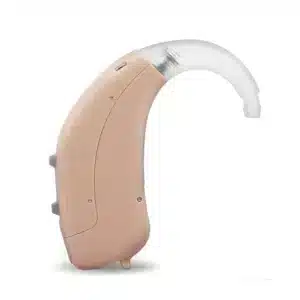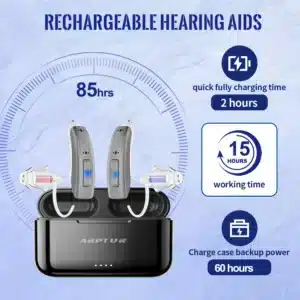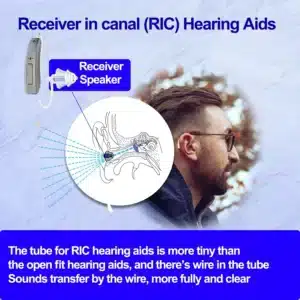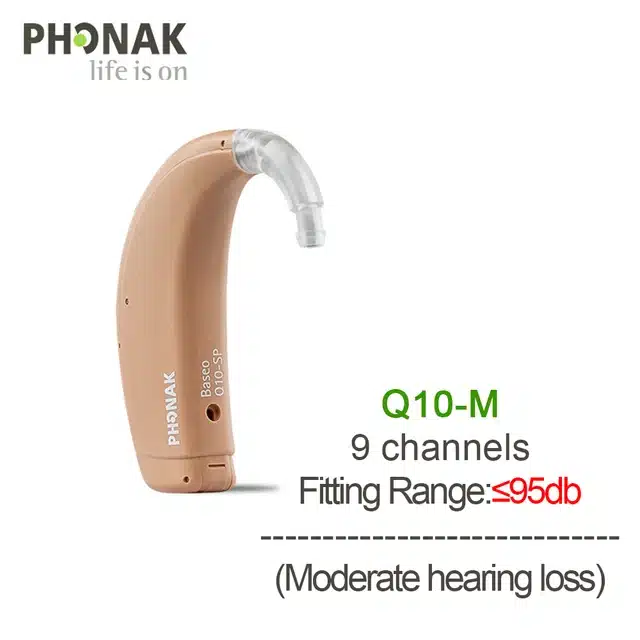Hearing Aid Fitting: Do Hearing Aids really Fit?
Yes, hearing aids are designed to fit, but the fit can vary depending on the type of hearing aid and individual anatomy. Here’s how different types of hearing aids fit and what to consider:
Types of Hearing Aid Fitting?
- Behind-the-Ear (BTE) Hearing Aids:
- Fit: These devices sit behind the ear and are connected to a custom ear mold or a soft ear tip through a thin tube.
- Adjustment: The ear mold or dome should fit snugly in the ear canal, and the behind-the-ear component should rest comfortably against the ear. The fit is usually adjustable for comfort.
- In-the-Ear (ITE) Hearing Aids:
- Fit: These hearing aids fit directly into the outer ear and are custom-made to match the shape of your ear.
- Adjustment: The device should sit securely in the ear bowl without causing discomfort. Custom molds are made from impressions of your ear, ensuring a personalized fit.
- Completely-in-Canal (CIC) and Invisible-in-Canal (IIC) Hearing Aids:
- Fit: These are smaller devices that fit deep into the ear canal and are less visible.
- Adjustment: They are custom-made to fit the unique shape of the ear canal. Proper fitting is crucial for comfort and effective sound delivery.
Factors Affecting Hearing Aid Fitting;
- Comfort: The hearing aid should not cause pain or discomfort. Proper fit involves ensuring that the device sits comfortably in the ear without causing pressure or irritation.
- Seal and Occlusion: For effective amplification and to prevent feedback (whistling), the hearing aid needs to create a good seal in the ear canal. An ill-fitting device can cause a sensation of “plugged-up” ears or lead to sound leakage.
- Adjustment and Fine-Tuning: Initial fitting might require adjustments to optimize comfort and performance. Follow-up appointments with an audiologist help to make necessary tweaks to the fit and settings.
- Hygiene and Maintenance: Regular cleaning and maintenance are essential for maintaining a good fit and ensuring the hearing aid continues to perform well.
Professional Fitting
Audiologists or hearing aid specialists play a crucial role in ensuring that hearing aids fit properly. They take ear impressions, adjust settings, and make any necessary modifications to enhance comfort and performance. If a hearing aid doesn’t fit well, it’s important to seek professional help to address the issue.
In summary, hearing aids are designed to fit well and enhance hearing, but achieving the best fit requires attention to individual needs and periodic adjustments.
How Does Hearing Aid Work?
Hearing aids work by amplifying sound and making it clearer for individuals with hearing loss. Here’s a simplified overview of how they operate:
- Sound Collection: The hearing aid has a tiny microphone that picks up sound from the environment. This sound is converted into electrical signals.
- Signal Processing: The electrical signals are sent to a processor inside the hearing aid. This component analyzes and processes the sound to enhance it. Modern hearing aids use digital processing to adjust the sound based on various settings and the user’s hearing needs.
- Amplification: The processed signals are then amplified. The degree of amplification depends on the specific hearing loss and the settings adjusted by the user or their audiologist.
- Sound Delivery: The amplified sound is converted back into acoustic signals and delivered into the ear through a speaker (or receiver). For behind-the-ear (BTE) models, this involves sound traveling through a tube and ear mold or dome. For in-the-ear (ITE) models, the sound is delivered directly into the ear canal.
- Feedback Control: Modern hearing aids are equipped with feedback suppression systems to reduce or eliminate whistling sounds that can occur when sound from the speaker re-enters the microphone.
- User Controls: Many hearing aids have controls or apps that allow users to adjust volume, change programs for different listening environments, and customize settings to their preferences.
In essence, hearing aids amplify and refine sound to help individuals hear better, tailored to their specific hearing loss and needs.

8 Steps with Hearing Aid Fitting
Hearing aid fitting is a process where a hearing healthcare professional adjusts and programs the hearing aids to suit the specific needs and preferences of the individual. Here are the typical steps involved in a hearing aid fitting:
1. **Initial Assessment**: The process begins with a thorough assessment of your hearing loss by an audiologist or hearing instrument specialist. They will evaluate your hearing ability, lifestyle, and communication needs.
2. **Selection of Hearing Aids**: Based on the assessment, the professional will recommend suitable hearing aids that match your hearing loss, lifestyle, and budget. There are different types and styles of hearing aids available, such as behind-the-ear (BTE), in-the-ear (ITE), and completely-in-the-canal (CIC) devices.
3. **Customization and Programming**: Once the hearing aids are selected, they are programmed to amplify sounds according to your unique hearing profile. This programming can be fine-tuned to adjust for specific frequencies and environments where you struggle to hear.
4. **Verification**: After programming, the audiologist will conduct tests to ensure the hearing aids are providing the right amplification for your hearing needs. This may involve speech tests and adjustments based on your feedback.
5. **Orientation and Training**: You will receive guidance on how to use and maintain your hearing aids. This includes inserting and removing them, adjusting settings, and cleaning them properly.
6. **Follow-Up**: Follow-up appointments are scheduled to monitor your progress and make any necessary adjustments. Your hearing can change over time, so periodic check-ups are important to ensure your hearing aids continue to provide optimal performance.
7. **Counseling**: The fitting process often includes counseling on communication strategies, managing expectations, and addressing any concerns you may have about wearing hearing aids.
8. **Trial Period**: Many clinics offer a trial period during which you can wear the hearing aids in various situations to determine if they meet your needs before committing to a purchase.
Overall, hearing aid fitting is a personalized process aimed at maximizing your ability to hear and communicate effectively in different environments.

Can Hearing Aids be fitted to Another Person?
Hearing aids are typically not designed to be easily fitted to another person. Here are a few reasons why:
- Custom Fit: Hearing aids are often customized to fit the unique shape and size of an individual’s ear. Custom molds or ear tips are specifically made based on ear impressions, and these are tailored to the original user’s ear canal.
- Personalized Programming: Hearing aids are programmed to match the specific hearing loss and auditory preferences of the original wearer. The settings, including amplification levels and frequency adjustments, are tailored to their unique hearing profile.
- Comfort and Hygiene: Even if a hearing aid were physically compatible with another person’s ear, it might not be comfortable or hygienic. Hearing aids should be cleaned and maintained to avoid any health risks, and using someone else’s hearing aids can pose risks of infection or discomfort.
- Hearing Loss Variability: Hearing loss varies widely among individuals. The settings on a hearing aid are customized to address the specific type and degree of hearing loss, making it unsuitable for someone with a different hearing profile.
- Legal and Ethical Considerations: Hearing aids are considered medical devices and are typically prescribed and fitted by audiologists. Transferring a hearing aid from one person to another could bypass important medical oversight and adjustments.
How Should a Hearing Aid Fit?
A hearing aid should fit comfortably and securely in or on your ear. Here are some key points to ensure proper fit:
- Comfort: The hearing aid should sit snugly without causing pain or irritation. You shouldn’t feel pressure or discomfort after wearing it for a while.
- Correct Placement: For behind-the-ear (BTE) models, the device should rest comfortably behind your ear, with the tubing fitting snugly into the ear canal. For in-the-ear (ITE) or completely-in-canal (CIC) models, the device should fit snugly inside your ear canal or the outer ear without protruding or shifting.
- Seal: The ear mold or tip should create a good seal in your ear canal to ensure optimal sound quality and to prevent feedback (whistling noises).
- Adjustments: Many hearing aids come with adjustable settings that can help tailor the fit and function to your specific needs. It’s often necessary to fine-tune the fit with professional help.
- Hearing Specialist: If you experience persistent discomfort or problems with your hearing aid, it’s a good idea to consult with an audiologist or hearing aid specialist. They can make precise adjustments and ensure that the hearing aid is fitting correctly.
Proper fit is essential for effective hearing aid performance and comfort, so don’t hesitate to reach out for professional assistance if needed.
Open fit Hearing Aids:
Open fit hearing aids are a type of hearing aid design that has become increasingly popular in recent years. Here are some key features and benefits of open fit hearing aids:
- Design: Open fit hearing aids are small and discreet, fitting behind the ear with a thin tube or wire that delivers sound into the ear canal. Unlike traditional behind-the-ear (BTE) hearing aids, they leave the ear canal open, allowing natural sounds to enter.
- Comfort: They are known for their comfort due to their lightweight design and the fact that they don’t block the ear canal completely. This can reduce the feeling of occlusion or the “head in a barrel” sensation that some users experience with other types of hearing aids.
- Cosmetic Appeal: Open fit hearing aids are less visible compared to larger BTE models, making them a preferred choice for individuals concerned about aesthetics.
- Sound Quality: They provide natural sound quality because they allow low-frequency sounds to enter the ear naturally while amplifying higher frequencies as needed. This can result in better localization of sound and a more natural listening experience.
- Feedback Reduction: Modern open fit hearing aids often include advanced feedback cancellation technology, which helps prevent whistling or feedback noises that can occur with other types of hearing aids.
- Suitability for Mild to Moderate Hearing Loss: Open fit hearing aids are typically suitable for individuals with mild to moderate high-frequency hearing loss. They may not be as effective for severe hearing loss where more amplification is required.
- Maintenance: They are generally easy to maintain and clean, requiring regular care to keep the thin tube or wire clear of wax and debris.
What Does an Open Fit Hearing Aid Look Like?
An open fit hearing aid is designed to be less visible and more comfortable by allowing natural sound to enter the ear while amplifying only the sounds that are difficult to hear. Here’s what it generally looks like:
- Tiny Device: The hearing aid itself is usually quite small and sits behind the ear (BTE). It’s less conspicuous compared to traditional models.
- Thin Tubing: It features a very thin, flexible tube that connects the behind-the-ear unit to a small, soft ear tip or dome that sits inside the ear canal. The tubing is often discreet and less noticeable.
- Ear Tip/Dome: The part that sits inside the ear canal is a small, soft, and often transparent or flesh-colored dome or tip. This tip is designed to be comfortable and to let low-frequency sounds enter the ear naturally while amplifying higher-frequency sounds.
- Ventilation: Open fit hearing aids typically have a vent in the ear tip or dome that allows natural sounds and your own voice to pass through, reducing the feeling of “plugged-up” ears that some hearing aids can cause.
- Behind-the-Ear Component: The behind-the-ear portion is where the battery, amplifier, and controls are located. It’s usually small and designed to be as discreet as possible.
Overall, open fit hearing aids aim to provide a more natural hearing experience by reducing occlusion and allowing for better airflow in the ear canal.
Self Fitting Hearing Aids:
Self-fitting hearing aids refer to devices that can be programmed and adjusted by the user themselves, without the need for frequent visits to a professional audiologist or hearing instrument specialist. Here are some key points to consider about self-fitting hearing aids:
- Technology: Self-fitting hearing aids typically rely on advanced digital technology and software that allows users to adjust settings such as volume, sound amplification, and program settings via a smartphone app or computer software.
- Accessibility: They are designed to provide greater accessibility and convenience for individuals who may not have easy access to audiological services or who prefer to manage their hearing aid adjustments independently.
- Customization: Users can personalize their hearing experience by adjusting settings based on their specific hearing needs, preferences, and different listening environments.
- Initial Setup: The initial setup of self-fitting hearing aids often involves an automated or guided process where the user performs a self-assessment of their hearing and preferences using the accompanying software or app.
- Flexibility: They offer flexibility in terms of adjusting settings in real-time, allowing users to make changes on the fly depending on their current environment or listening conditions.
- Limitations: Self-fitting hearing aids may not be suitable for everyone, especially individuals with complex hearing loss or those who require precise programming and adjustments that can only be provided by a trained audiologist or hearing specialist.
- Monitoring and Support: Some self-fitting hearing aids provide remote monitoring capabilities, allowing audiologists or hearing care professionals to remotely adjust settings or provide guidance and support as needed.
- Cost Considerations: They may offer cost savings compared to traditional hearing aids that require frequent professional visits for adjustments and programming.
Hearing Aid Fitting:- It’s important to note that while self-fitting hearing aids can be convenient and cost-effective, they are not suitable for all types of hearing loss or individual preferences.

How Can I Make my Hearing Aid Fit Better?
Improving the fit of your hearing aid can significantly enhance both comfort and performance. Here are some steps you can take:
- Consult Your Audiologist: Start by visiting your audiologist or hearing specialist. They can make precise adjustments and offer professional advice tailored to your specific needs.
- Check the Ear Mold or Tip: If you have a behind-the-ear (BTE) hearing aid, ensure the ear mold or tip fits snugly in your ear canal. It should be comfortable and not too tight. If it’s uncomfortable or causing feedback, it might need adjusting or replacing.
- Adjust the Tubing: For BTE models, the tubing that connects the hearing aid to the ear mold should be properly fitted. Check for any kinks or damage in the tubing. If it’s too short or too long, it can affect the fit and comfort.
- Try Different Domes: If your hearing aid uses domes or tips, experiment with different sizes or styles. Soft silicone or foam domes can provide a more comfortable and secure fit.
- Use Adhesive or Comfort Products: There are specialized adhesives or comfort products designed to help secure hearing aids and enhance comfort. These can be especially useful if your hearing aid tends to shift or feels loose.
- Clean Regularly: Keeping your hearing aid clean helps maintain a good fit. Earwax or debris can affect the fit and performance. Follow your hearing aid’s cleaning instructions and schedule regular cleanings.
- Check for Proper Insertion: Ensure you’re inserting the hearing aid correctly. For BTE models, the hearing aid should rest comfortably behind your ear with the tubing fitting securely in the ear canal. For in-the-ear (ITE) models, the device should fit snugly inside your ear without causing discomfort.
- Address Discomfort: If you’re experiencing discomfort, identify the specific area causing the issue—whether it’s pressure behind the ear or irritation inside the ear canal. Adjustments or different ear molds might be needed to address these issues.
- Follow Manufacturer Guidelines: Refer to the manufacturer’s guidelines for any specific fitting instructions or recommendations.
- Seek Professional Adjustments: If self-adjustments aren’t resolving the issue, consult your audiologist. They can provide custom adjustments and ensure the hearing aid is set up optimally for your hearing needs.
How Long Does Hearing Aid Fitting Take?
The fitting of a hearing aid typically involves several steps and can vary in duration based on individual needs and the complexity of the fitting. Here’s a general outline of what to expect:
- Initial Consultation: This meeting, where your audiologist assesses your hearing loss, discusses your needs, and selects the appropriate hearing aid model, usually lasts around 1 to 2 hours. This step includes taking impressions of your ear if custom fittings are required.
- Hearing Aid Fitting Appointment: During this appointment, which can take about 1 to 1.5 hours, the audiologist will fit the hearing aids, program them according to your hearing loss and preferences, and provide instructions on how to use them. The fitting process includes:
- Inserting the Hearing Aids: Ensuring they sit comfortably and securely.
- Programming: Adjusting settings to match your hearing loss and preferences.
- Verification: Testing and fine-tuning the hearing aids to ensure they are working properly.
- Follow-Up Appointments: After the initial fitting, follow-up visits are often scheduled to make any necessary adjustments and to address any issues or discomfort. These appointments usually last about 30 minutes to an hour.
Facebook Page
X Page
Instagram Page






